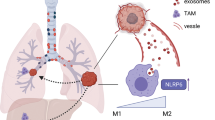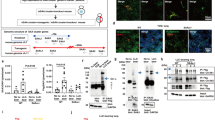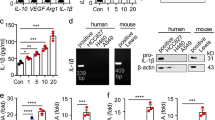Abstract
A large number of macrophages and haematopoietic progenitor cells accumulate in pre-metastatic lungs1,2 in which chemoattractants, such as S100A8 and S100A9, are produced by distant primary tumours serving as metastatic soil3. The exact mechanism by which these chemoattractants elicit cell accumulation is not known. Here, we show that serum amyloid A (SAA) 3, which is induced in pre-metastatic lungs by S100A8 and S100A9, has a role in the accumulation of myeloid cells and acts as a positive-feedback regulator for chemoattractant secretion. We also show that in lung endothelial cells and macrophages, Toll-like receptor (TLR) 4 acts as a functional receptor for SAA3 in the pre-metastatic phase. In our study, SAA3 stimulated NF-κB signalling in a TLR4-dependent manner and facilitated metastasis. This inflammation-like state accelerated the migration of primary tumour cells to lung tissues, but this was suppressed by the inhibition of either TLR4 or SAA3. Thus, blocking SAA3–TLR4 function in the pre-metastatic phase could prove to be an effective strategy for the prevention of pulmonary metastasis.
This is a preview of subscription content, access via your institution
Access options
Subscribe to this journal
Receive 12 print issues and online access
$209.00 per year
only $17.42 per issue
Buy this article
- Purchase on Springer Link
- Instant access to full article PDF
Prices may be subject to local taxes which are calculated during checkout





Similar content being viewed by others
References
Hiratsuka, S. et al. MMP9 induction by vascular endothelial growth factor receptor-1 is involved in lung-specific metastasis. Cancer Cell 2, 289–300 (2002).
Kaplan, R. N. et al. VEGFR1-positive haematopoietic bone marrow progenitors initiate the pre-metastatic niche. Nature 438, 820–827 (2005).
Hiratsuka, S., Watanabe, A., Aburatani, H. & Maru, Y. Tumour-mediated lung metastasis. Nature Cell Biol. 8, 1369–1375 (2006).
Paget, S. The distribution of secondary growths in cancer of the breast. Cancer Metastasis Rev. 8, 98–101, (1989).
Egeblad, M. & Werb, Z. New functions for the matrix metalloproteinases in cancer progression. Nature Rev. Cancer 2, 161–174 (2002).
Liang, T. S., Wang, J. M., Murphy, P. M. & Gao, J. L. Serum amyloid A is a chemotactic agonist at FPR2, a low-affinity N-formylpeptide receptor on mouse neutrophils. Biochem. Biophys. Res. Commun. 270, 331–335 (2000).
He, R., Sang, H. & Ye, R. D. Serum amyloid A induces IL-8 secretion through a G protein-coupled receptor, FPRL1/LXA4R. Blood 101, 1572–1581 (2003).
Larson, M. A., Wei, S. H., Weber, A., Weber, A. T. & McDonald, T. L. Induction of human mammary-associated serum amyloid A3 expression by prolactin or lipopolysaccharide. Biochem. Biophys. Res. Commun. 301, 1030–1037 (2003).
Meek, R. L. & Benditt, E. P. Rat tissues express serum amyloid A protein-related mRNAs. Proc. Natl Acad. Sci. USA 86, 1890–1894 (1989).
Meek, R. L., Eriksen, N. & Benditt, E. P. Murine serum amyloid A3 is a high density apolipoprotein and is secreted by macrophages. Proc. Natl Acad. Sci. USA 89, 7949–7952 (1992).
Wang, H. & Liao, W. S. Functional analysis of a minimal mouse serum amyloid A3 promoter in transgenic mice. Amyloid 8, 250–256 (2001).
Lin, Y. et al. Hyperglycemia-induced production of acute phase reactants in adipose tissue. J. Biol. Chem. 276, 42077–42083 (2001).
Son, D. S., Roby, K. F. & Terranov, P. F. Tumor necrosis factor induces serum amyloid A3 in mouse granulosa cells. Endocrinology 145, 2245–2252 (2004).
Huang, B. et al. Toll-like receptors on tumor cells facilitate evasion of immune surveillance. Cancer Res. 65, 5009–5014 (2005).
Verghese, M. W. & Snyderman, R. Endotoxin (LPS) stimulates in vitro migration of macrophages from LPS-resistant mice but not from LPS-sensitive mice. J. Immunol. 128, 608–613 (1982).
Beutler, B. Toll-like receptors: how they work and what they do. Curr. Opin. Hematol. 9, 2–10 (2002).
Ogawa, T. et al. Cell activation by Porphyromonas gingivalis lipid A molecule through Toll-like receptor 4- and myeloid differentiation factor 88-dependent signaling pathway. Int. Immunol. 14, 1325–1332 (2002).
Miyake, K., Yamashita, Y., Ogata, M., Sudo, T. & Kimoto, M. RP105, a novel B cell surface molecule implicated in B cell activation, is a member of the leucine-rich repeat protein family. J. Immunol. 154, 3333–3340 (1995).
Akashi, S. et al. Lipopolysaccharide interaction with cell surface Toll-like receptor 4-MD-2: higher affinity than that with MD-2 or CD14. J. Exp. Med. 198, 1035–1042 (2003).
Vogl, T. et al. Mrp8 and Mrp14 are endogenous activators of Toll-like receptor 4, promoting lethal, endotoxin-induced shock. Natue Med. 13, 1042–1049 (2007).
Akira, S. & Takeda, K. Toll-lke receptor signaling. Nature Rev. Immunol. 4, 499–511 (2004).
Beutler, B. Inferences, questions and possibilities in Toll-like receptor signalling. Nature 430, 257–263 (2004).
Vabulas, R. M. et al. HSP70 as endogenous stimulus of the Toll/Interleukin-1 receptor signal pathway. J. Biol. Chem. 277, 15107–15112 (2002).
Termeer, C. et al. Oligosaccharides of hyaluronan activate dendritic cells via Toll-like receptor 4. J. Exp. Med. 195, 99–111 (2002).
Jiang, D. et al. Regulation of lung injury and repair by Toll-like receptors and hyaluronan. Nature Med. 11, 1173–1179 (2005).
Smiley, S. T., King, J. A. & Hancock, W. W. Fibrinogen stimulates macrophage chemokine secretion through Toll-like receptor 4. J. Immunol. 167, 2887–2894 (2001).
Marx, J. Cancer research. Inflammation and cancer: the link grows stronger. Science 306, 966–968 (2004).
Greten, F. R. et al. IKKbeta links inflammation and tumorigenesis in a mouse model of colitis-associated cancer. Cell 118, 285–296 (2004).
Hoshino, K. et al. Cutting edge: Toll-like receptor 4 (TLR4)-deficient mice are hyporesponsive to Lipopolysaccharide: evidence for TLR4 as the Lps gene product. J. Immunol. 162, 3749–3752 (1999).
Dong, Q. G. et al. A general strategy for isolation of endothelial cells from murine tissues. Characterization of two endothelial cell lines from the murine lung and subcutaneous sponge implants. Arterioscler. Thromb. Vasc. Biol. 17, 1599–1604 (1997).
Acknowledgements
We thank P. E. Scherer for providing the anti-mouse SAA3 antibody and pGEX-SAA3 vector, and T. Noda for preparation of the VEGFR1TK−/− mouse. We are grateful to B. Panda for checking the manuscript and also O. N. Witte for critical reading of manuscript and providing comments. This study was partly supported by Grants-in-Aid for Scientific Research from the Ministry of Education, Culture, Sports, Science and Technology, 12147210 (Y.M.) and 16101006 (H.A.) the NIBIO program and NFAT project of New Energy and Industrial Technology Development Organization (H.A.) and Uehara foundation (S.H.)
Author information
Authors and Affiliations
Contributions
S.H., Y.S. mainly contributed to animal studies; A.W. and S.I. contributed to molecular analysis; S.A.T., K.M., M.S. and S.A. supplied animals and materials; Y.M. designed and organized the work; H.A. and Y.M. supervised the work.
Corresponding author
Ethics declarations
Competing interests
The authors declare no competing financial interests.
Supplementary information
Supplementary Information
Supplementary Information (PDF 1775 kb)
Rights and permissions
About this article
Cite this article
Hiratsuka, S., Watanabe, A., Sakurai, Y. et al. The S100A8–serum amyloid A3–TLR4 paracrine cascade establishes a pre-metastatic phase. Nat Cell Biol 10, 1349–1355 (2008). https://doi.org/10.1038/ncb1794
Received:
Accepted:
Published:
Issue Date:
DOI: https://doi.org/10.1038/ncb1794
This article is cited by
-
Myeloid-derived suppressor cells in cancer and cancer therapy
Nature Reviews Clinical Oncology (2024)
-
Unveiling the role of osteosarcoma-derived secretome in premetastatic lung remodelling
Journal of Experimental & Clinical Cancer Research (2023)
-
Metabolism, metabolites, and macrophages in cancer
Journal of Hematology & Oncology (2023)
-
Pulmonary interleukin 1 beta/serum amyloid A3 axis promotes lung metastasis of hepatocellular carcinoma by facilitating the pre-metastatic niche formation
Journal of Experimental & Clinical Cancer Research (2023)
-
Novel multivalent S100A8 inhibitory peptides attenuate tumor progression and metastasis by inhibiting the TLR4-dependent pathway
Cancer Gene Therapy (2023)



